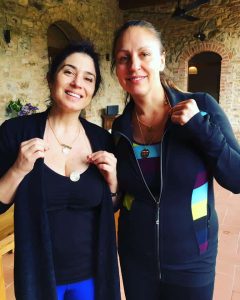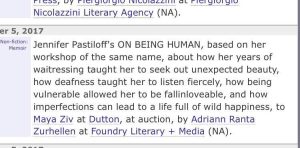By Dana Mich
I glanced down at the two pink lines gazing up at me from their glossy plastic eyelets. I set the First Response test on my bathroom sink and bit my lip as I ran the tap. It felt too good to be true.
It was the day of my thirtieth birthday, and Mother’s Day. May fourteenth, twenty-seventeen. The previous evening’s cake and candles, and that morning’s sunlit family brunch—gilded with yogurt parfaits and a medley of quiches—hovered in my peripheral view. If anything, those two little tick-marks should have been the cherry on top of an already serendipitous twenty-four hours in my life. But this was my third positive test in nine months with no baby or expectant bump to show for it. Instead of rejoicing on that first day of the decade I’d slated to be my parenting years, I pleaded to the universe: “Please just let me have this baby. I swear, I’ll be so careful.”
My doctor had explained my condition to me, months earlier—the stitch in her brow revealing her surprise that I’d been able to conceive at all. “Your miscarriages are due to a luteal phase insufficiency,” she advised. “It’s when the second half of your cycle, after you ovulate, is shorter than twelve days—the minimum required to sustain a healthy pregnancy. And yours is…” she flipped through my charts.
“Eight.” I said, staring down at my shoes. “Every time. Eight.”
We talked common causes: eating disorders, nutrient deficiencies, undue stress. None of them fit my profile. The persistent aberration in my cycle remained a mystery. But what wasn’t a mystery at all by that point was the repeated outcome: a period that would unexpectedly vanish a day or two after its arrival, followed by a faint positive pregnancy test. And then, the quasi-pregnant limbo I’d endure for a few weeks until my weakened hormones gave way to the excruciating inevitable: the cold sweats, the tremors, the knifelike abdominal pangs and hemorrhaging that each miscarriage guaranteed. Not to mention the emotional aftermath—the ghostly foe that took up residence once the physical manifestations left the scene, insisting that my future attempts to conceive would likely be met with the loss of life, rather than the promise of it.
With a weekly dose of talk therapy, my anxiety eventually ebbed away enough for me to focus on the medically curative measures. Together with my physician, I devised an exhaustive regimen: herbal fertility pills (whose efficacy was unclear, but at least worth a try), a technicolor cocktail of dietary supplements that made my stomach gurgle and lurch, and a Clomid prescription to coax my ovaries into cooperating. I was skeptical, but the result had been an overwhelming success: in just one month’s time, the second half of my cycle lengthened to twelve days. I’d hurdled over the threshold of “insufficiency” into the land of parenting possibility, leading my doctor to proclaim that my husband and I were safe to try again.
Despite the luck we’d had with the getting pregnant piece of the fertility puzzle, John and I knew better than to expect immediate successs. What we did hope for, however, was a definitive answer. An end to the “maybe babies” as we called them—our attempt to infuse some levity into our otherwise distressing reality. And to our relief, our Mother’s Day-birthday pregnancy was indeed different. The second line appeared instantly, and was much darker than before. The blood tests over the next week broke the stagnant line of my many previous draws, too, replacing them with a trajectory of healthy, climbing hormone levels. There was no mistaking it: though it was still early, this time I was truly pregnant.
The days turned into weeks, and one by one, we surpassed the timelines of our earlier miscarriages. We made no mention of a nursery, and didn’t dare talk baby names. My best defense against the fear of another failed pregnancy was to keep it out of mind, and John honored that. Other than the scheduled eight-week appointment that sat on our calendars, we delighted in the fact that our lives could feel normal again. The only difference in our routines was the small way we celebrated each day that passed without mishap.“Hug me,” John smiled, opening his arms when he returned home from work. I tiptoed into his embrace, allowing myself to feel the hope that beat quietly between us.
At six weeks, the telltale signs of nausea and sensitivity arrived and I felt comforted by the belief that our baby was viable. But just a few days later, my body made its best attempt to blot our pregnancy out.
“Shit.” I whimpered to John from the bathroom, a bloodied wad of toilet paper in hand. “It’s another miscarriage.”
We rushed to my Ob/Gyn’s office, agreeing to see whichever physician was first available, and braced ourselves for the worst. But in the exam room, my doctor eased our fears. “It looks like you have some cervical swelling. We don’t like to see bleeding, of course, but it’s not terribly uncommon.” She switched on her handheld ultrasound, pressed the wand to my abdomen, and smiled. “And here…” she said, angling the small screen toward us, “…is your baby.” John and I stared at the image in disbelief. Our first ever visible embryo, no larger than a lentil, boasted a heartbeat that flickered like a tiny strobe light: there—gone, there—gone, there—gone.
In the two months that followed, our path swerved between its own extremes: the pelvic flare-ups that caused our scare appeared off and on throughout my first trimester, leaving me relieved one day and terrified the next. And all the while, a golf-ball sized cyst—a byproduct of the medication I’d taken to ovulate on time—threatened the need for potential surgical removal of the ovary onto which it clung.
“Pregnancy is just the best isn’t it? So easy and stress-free.” John often joked to make me smile. But my lips stayed as still and unmoving as I did, many days—my attempt to level out our tumultuous roller-coaster ride. Long gone were my cherished early-morning cardio workouts; my eight-pound dumbbells collected dust beneath our TV stand. In the rare instances I roused myself from my yogic savasana, I retrieved my iPod with the meditation track and a chia seed smoothie.
The day of my thirteen-week ultrasound arrived at the peak of my anxiety. With John by my side, I held back tears as the technician prepped the equipment. When the screen lit up, though, my jaw dropped. Our baby came into view, its head, spine and limbs all strikingly human. “Oh my God,” we whispered. “This is unreal.” The technician shifted the probe over my barely-there bump, focusing in on tiny pairs of arms and legs, hands and feet. “Is that a thumb? An elbow? A big toe?” We asked, our grins inching upward. After accounting for each feature, she zoomed back out, and what we saw left us speechless. Our peapod-sized fetus, so alive and unafraid, was performing aerobics I hadn’t dared to in months—bending its knees and flinging itself around as if my womb were a Bounce-n-Play.
The seconds turned to minutes. John and I hovered in a moment of awe until the technician jiggled the probe and released a frustrated sigh. She turned to me, eyebrows raised: “I’m going to need you to jump.”
“…I’m sorry?”
“I need the baby to reposition itself to get the right measurement. I’m going to step outside for a few minutes while you get to it!” She said.
The door latch clicked at her back and her feet scuffed down the carpeted hall. I looked to John from where I lay on the examining table. He shrugged his shoulders and laughed, his light green eyes brimming with the same worry-free optimism I’d always known and loved.
All this caution, and for what?
I thought back on everything we’d been through: My positive test on Mother’s Day; my doubt that the pregnancy would last. My doctor’s constant assurances; my sense of dread at each scare. The hopes I’d carried; the miscarriages I endured. At each turn, the warning signs and uncertainties had petrified me. And yet, there I was, having just witnessed our baby’s joyous somersaults on the monitor overhead—her twists and springs completely unfettered. Could I learn to embrace a fraction of that audacity? My journey to motherhood was certainly fraught with highs and lows, but it became clear to me then—that’s life.
I stood up and nodded at John, returning a timid smile. I let my chest rise and fall with one deep, awaited breath.
And I jumped.


